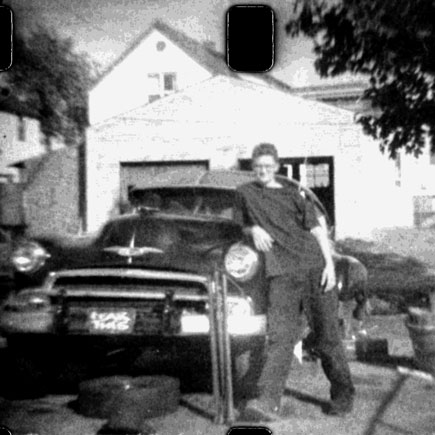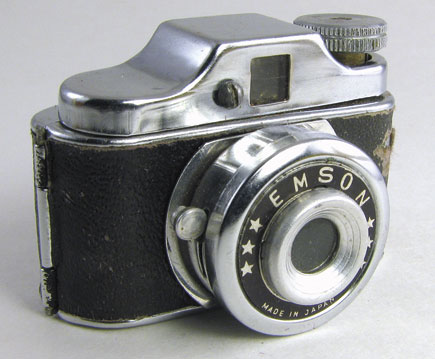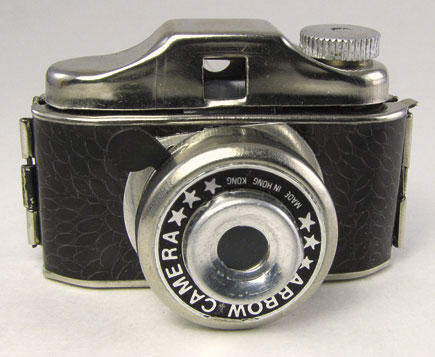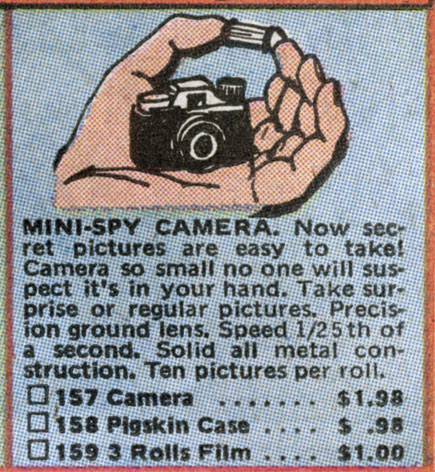Classic Cameras; So You Wanted To Be A Spy; Hit Cameras: “Secret Spy Cameras” Page 2
The question is: can you actually take photos with a Hit camera? The answer is yes, but you have to really want to. First you’ll need a camera. The usual online sources will turn up many of them, from big city camera shops to eBay, and the garden variety models are not expensive—a 10 spot plus shipping may get you started. My advice is to try to find one that is all there, and with a shutter that works. Check local antique shops and flea markets, too.
After you have a camera you’ll have to find or make film. Any original film for a Hit camera is going to be old and unusable. But you can make use of the little spools and the backing paper, so if you run into some original film, save it! The easiest film solution is to buy some. I only know of one supplier, Goat Hill Photo
(www.subclub.org/sponsors/goathil2.htm). Goat Hill Photo is a good source for all types of subminiature films, from Minox to Minolta and others, and Hit-sized film is actually in stock!
 |
|
|
You’re going to have to wind your own film onto the spools for loading into the camera. If you don’t have a darkroom in this digital age, you’ll find a changing bag invaluable. Details for loading film spools for any size can be found with a Google search, but you probably have the general idea. You could also slit your own film, cut down roll film, or cheat and use 16mm film rolled into the original Hit backing paper. Inventiveness and resourcefulness are key to successful Hit photography. While you’re at it, load the film into the camera in the changing bag, too. Once the camera is loaded and before you think about heading out to shoot, take a roll of black tape (electrical tape works fine) and tape the edges of the camera around the back openings. I’ve yet to find a Hit camera that is light-tight and you need to do all you can to prevent fogging.
 |
|
 |
|
 |
|
|
Shooting Tips
Remember, you’re working with (roughly) f/11 and 1⁄25 sec, so you’re going to be overexposing in sunlight unless you’ve found yourself some ISO 10 film. Look for shade, or shoot inside with the lights on. If you have a camera with a “B” setting, set it on a chair or table and try some time exposures. If you’re working in the sun hold a filter in front of the lens to reduce light. A yellow filter from your old black-and-white film days will cut some light and give you more contrast if you’re shooting black-and-white film, and you’re going to need all the contrast you can get because these single element lenses aren’t exactly punchy. Every Hit camera I’ve used takes in a lot more area than the viewfinder shows. Composition is iffy at best, sort of like shooting with a 28mm lens while viewing through a 50mm lens.
If you’re shooting black and white you’ll be doing your own developing and if you loaded up with a C-41 film you should be able to find a lab that does “dip and dunk” processing so the odd size won’t matter. Some minilabs have processors that can actually pull smaller than 35mm odd sized films through the soup and give you negatives. Check with your friendly neighborhood lab operator.
Patience is vital, and being happy with one or two frames that look like something is a plus. You can find plenty of Hit camera collectors on the Internet but few who actually take photos with them. It is not a task for the faint of heart but one where success can lead to very unique photographs and a deep feeling of accomplishment.
- Log in or register to post comments

































